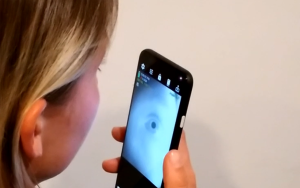
Researchers at the University of California, San Diego recently developed a mobile app that allows people test for ADHD, Alzheimer’s disease, as well as other neurological diseases just by recording closeups of their eyes.
The app makes use of a near-infrared camera and the regular selfie camera, especially those found in newer smartphones, to track the changes in size of a person’s size. In this way, a person’s cognitive condition can be measured.
The paper will be presented at the ACM Computer Human Interaction Conference on Human Factors in Computing Systems (CHI2022) in New Orleans from April 30th to May 5th.
‘While there is still a lot of work to be done, I am excited about the potential for using this technology to bring neurological screening out of clinical lab settings and into homes,’ said Colin Barry, first author of the paper and PhD student at UC. ‘We hope that this opens the door to novel explorations of using smartphones to detect and monitor potential health problems earlier on.’
Research has shown that the size of a person’s pupil can provide information about his neurological functions. The pupil increases in size when a person carries out a complex cognitive task or hears an unexpected sound.
The pupil size is measured by the ‘pupil response test’. The test however requires specialized and expensive equipment, making it extremely difficult to perform outside the clinic or lab.
Researchers at the UC San Diego Center for Mental Health Technology (MHTech Center) collaborated with the engineers in the Digital Health Lab for the development of an affordable and more effective solution.
‘A scalable smartphone assessment tool that can be used for large-scale community screenings could facilitate the development of pupil response tests as minimally-invasive and inexpensive tests to aid in the detection and understanding of diseases like Alzheimer’s disease. This could have a huge public health impact,’ said Eric Granholm, Professor of Psychiatry and Director of the MHTech Center.
The app developed by the researchers makes use of the near-infrared camera in a smartphone to detect a person’s pupil. In that spectrum, the pupil can be easily told apart from the iris. This would then allow the app to calculate pupil size with sub-millimeter accuracy. The smartphone’s selfie camera takes a color picture which the app uses to measure the stereoscopic distance between the user and the smartphone. This distance is then used to convert the pupil size from the near-infrared image into millimeter units.
The measurements taken by the app can be compared to those taken by a pupillometer— the gold standard for measuring pupil size.
Various features were also included in the app to make it easier to use for older adults.
‘For us, one of the most important factors in technology development is to ensure that these solutions are ultimately usable for anyone. This includes individuals like older adults who might not be accustomed to using smartphones,’ said Barry.
The researchers, in collaboration with older adult participants, designed a simple app interface which enables users to self-administer pupil response tests. This interface includes image-based instructions, voice commands, and an affordable, plastic scope directing the user to keep their eye within the view of the camera.
‘By testing directly with older adults, we learned about ways to improve our system’s overall usability and even helped us innovate older adult specific solutions that make it easier for those with different physical limits to still use our system successfully,’ said Edward Wang, Faculty Member in the UC San Diego Design Lab. ‘When developing technologies, we must look beyond function as the only etic of success, but understand how our solutions will be utilized by end-users who are very diverse.’
By Marvellous Iwendi
Source: UCSD News